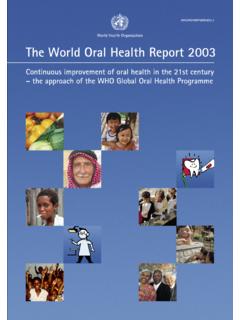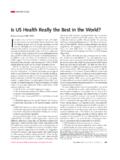Transcription of he WORLD HEALTH REPORT 2000
1 WORLD HEALTH ORGANIZATION. he WOR L D. HE A LT H. R E P ORT. 2000. ealth ystems: mproving erformance ii The WORLD HEALTH REPORT 2000. WHO Library Cataloguing in Publication Data The WORLD HEALTH REPORT 2000 : HEALTH systems : improving performance. 1. WORLD HEALTH 2. HEALTH systems plans 3. Delivery of HEALTH care 4. HEALTH services administration 5. Financing, HEALTH 6. HEALTH services accessibility 7. Social justice 8. HEALTH care evaluation mechanisms I. Title: HEALTH systems : improving performance ISBN 92 4 156198 X (NLM Classification: WA ). ISSN 1020-3311. The WORLD HEALTH Organization welcomes requests for permission to reproduce or translate its publica- tions, in part or in full. Applications and enquiries should be addressed to the Office of Publications, WORLD HEALTH Organization, 1211 Geneva 27, Switzerland, which will be glad to provide the latest information on any changes made to the text, plans for new editions, and reprints and translations already available.
2 WORLD HEALTH Organization 2000. All rights reserved. The designations employed and the presentation of the material in this publication, including tables and maps, do not imply the expression of any opinion whatsoever on the part of the Secretariat of the WORLD HEALTH Organization concerning the legal status of any country, territory, city or area or of its authorities, or concerning the delimitation of its frontiers or boundaries. Dotted lines on maps represent approximate border lines for which there may not yet be full agreement. The mention of specific companies or of certain manufacturers' products does not imply that they are endorsed or recommended by the WORLD HEALTH Organization in preference to others of a similar nature that are not mentioned. Errors and omissions excepted, the names of proprietary products are distin- guished by initial capital letters.
3 Information concerning this publication can be obtained from: WORLD HEALTH REPORT WORLD HEALTH Organization 1211 Geneva 27, Switzerland Fax: (41-22) 791 4870. Email: Copies of this publication can be ordered from: The principal writers of this REPORT were Philip Musgrove, Andrew Creese, disease, disability-adjusted life expectancy, HEALTH inequalities, responsive- Alex Preker, Christian Baeza, Anders Anell and Thomson Prentice, with con- ness, fairness of financial contribution, HEALTH system preferences, national tributions from Andrew Cassels, Debra Lipson, Dyna Arhin Tenkorang and HEALTH accounts and profiles, performance analysis and basic economic data. Mark Wheeler. The REPORT was directed by a steering committee formed by Members of each working group are listed in the Acknowledgements. Mana- Julio Frenk (chair), Susan Holck, Christopher Murray, Orvill Adams, Andrew gerial and technical leadership for the working groups was provided by Julio Creese, Dean Jamison, Kei Kawabata, Philip Musgrove and Thomson Prentice.
4 Frenk, Christopher Murray, Kei Kawabata, Alan Lopez and David Evans. A se- Valuable input was received from an internal advisory group and a regional ries of technical reports from each of the working groups provides details reference group, the members of which are listed in the Acknowledgements. on the methods, data and results, beyond the explanations included in the Additional help and advice were gratefully received from regional directors, Statistical Annex. executive directors at WHO headquarters and senior policy advisers to the The general approach to this REPORT was discussed at an interna- Director-General. tional consultative meeting on HEALTH systems, and the measurement of The conceptual framework that underpins the REPORT was formu- responsiveness was facilitated by a meeting of key informants.
5 Both meet- lated by Christopher Murray and Julio Frenk. The development of new ana- ings were held in Geneva in December 1999 and the participants are listed lytical methods and summary indicators, new international data collection in the Acknowledgements. efforts and extensive empirical analysis that form the basis for the REPORT The REPORT was edited by Angela Haden, assisted by Barbara was undertaken by over 50 individuals, most of them from the WHO Global Campanini. Administrative and technical support for the WORLD HEALTH Re- Programme on Evidence for HEALTH Policy, organized in eleven working port team were provided by Shelagh Probst, Michel Beusenberg, Amel groups. These groups covered basic demography, cause of death, burden of Chaouachi and Chrissie Chitsulo. The index was prepared by Liza Weinkove.
6 The cover shows a photograph of a sculpture entitled Ascending Horizon by Rafael Barrios, in Caracas, Venezuela. The photograph by Mireille Vautier is reproduced with the kind permission of ANA Agence photographique de presse, Paris, France. Design by Marilyn Langfeld. Layout by WHO Graphics Printed in France 2000/12934 Sadag 30 000. Overview iii CONTENTS. MESSAGE FROM THE DIRECTOR-GENERAL VII. OVERVIEW XI. How HEALTH systems have evolved xiii The potential to improve xiv Providing better services xv Finding a better balance xvi Protecting the poor xviii CHAPTER 1. WHY DO HEALTH SYSTEMS MATTER? 1. The changing landscape 3. What is a HEALTH system? 5. What do HEALTH systems do? 7. Why HEALTH systems matter 8. How modern HEALTH systems evolved 11. Three generations of HEALTH system reform 13. Focusing on performance 17.
7 CHAPTER 2. HOW WELL DO HEALTH SYSTEMS PERFORM? 21. Attainment and performance 23. Goals and functions 23. Goodness and fairness: both level and distribution matter 26. Measuring goal achievement 27. Overall attainment: goodness and fairness combined 40. Performance: getting results from resources 40. Improving performance: four key functions 44. CHAPTER 3. HEALTH SERVICES: WELL CHOSEN, WELL ORGANIZED? 47. Organizational failings 49. People at the centre of HEALTH services 50. Choosing interventions: getting the most HEALTH from resources 52. Choosing interventions: what else matters? 55. Choosing interventions: what must be known? 57. Enforcing priorities by rationing care 58. After choosing priorities: service organization and provider incentives 61. Organizational forms 62. iv The WORLD HEALTH REPORT 2000.
8 Service delivery configurations 63. Aligning incentives 64. Integration of provision 68. CHAPTER 4. WHAT RESOURCES ARE NEEDED? 73. Balancing the mix of resources 75. Human resources are vital 77. Adjusting to advances in knowledge and technology 81. Public and private production of resources 82. The legacy of past investments 84. HEALTH care resource profiles 85. Changing investment patterns 88. The way forward 90. CHAPTER 5. WHO PAYS FOR HEALTH SYSTEMS? 93. How financing works 95. Prepayment and collection 97. Spreading risk and subsidizing the poor: pooling of resources 99. Strategic purchasing 104. Organizational forms 108. Incentives 110. How financing affects equity and efficiency 113. CHAPTER 6. HOW IS THE PUBLIC INTEREST PROTECTED? 117. Governments as stewards of HEALTH resources 119. What is wrong with stewardship today?
9 120. HEALTH policy vision for the future 122. Setting the rules, ensuring compliance 124. Exercising intelligence, sharing knowledge 129. Strategies, roles and resources: who should do what? 132. What are the challenges? 135. How to improve performance 137. STATISTICAL ANNEX 143. Explanatory notes 144. Annex Table 1 HEALTH system attainment and performance in all Member States, ranked by eight measures, estimates for 1997 152. Annex Table 2 Basic indicators for all Member States 156. Annex Table 3 Deaths by cause, sex and mortality stratum in WHO Regions, estimates for 1999 164. Overview v Annex Table 4 Burden of disease in disability-adjusted life years (DALYs). by cause, sex and mortality stratum in WHO Regions, estimates for 1999 170. Annex Table 5 HEALTH attainment, level and distribution in all Member States, estimates for 1997 and 1999 176.
10 Annex Table 6 Responsiveness of HEALTH systems, level and distribution in all Member States, WHO indexes, estimates for 1999 184. Annex Table 7 Fairness of financial contribution to HEALTH systems in all Member States, WHO index, estimates for 1997 188. Annex Table 8 Selected national HEALTH accounts indicators for all Member States, estimates for 1997 192. Annex Table 9 Overall HEALTH system attainment in all Member States, WHO index, estimates for 1997 196. Annex Table 10 HEALTH system performance in all Member States, WHO indexes, estimates for 1997 200. LIST OF MEMBER STATES BY WHO REGION AND. MORTALITY STRATUM 204. ACKNOWLEDGEMENTS 206. INDEX 207. TABLES. Table Interventions with a large potential impact on HEALTH outcomes 53. Table Examples of organizational incentives for ambulatory care 67. Table Estimated out-of-pocket share in HEALTH spending by income level, 1997 96.













